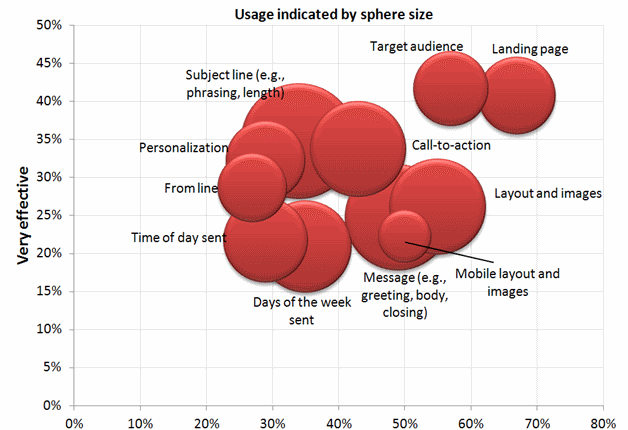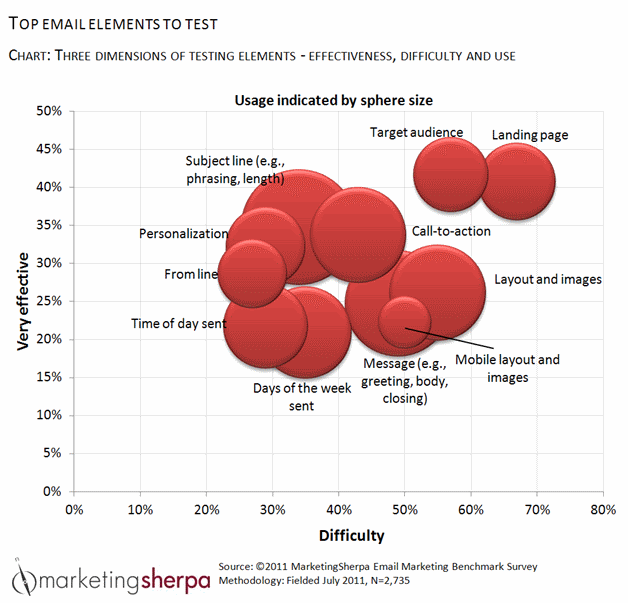As we gear up to test the subject lines suggested by you, the MarketingExperiments blog reader, in our recent contest, I thought it would be worthwhile to take a look at some email testing research conducted by our sister company, MarketingSherpa:
This research chart, from the MarketingSherpa 2011 Email Marketing Advanced Practices Handbook, packs a lot of interesting information in a small amount of space, so let’s break down just the most common, most effective and easiest elements to test …
Most common element to test – subject line (e.g., phrasing, length)
Not surprisingly, the subject line is the most common element to test. According to MarketingSherpa research, 72% of marketers test the subject line. As you can see in the chart, subject line testing lies at that golden nexus of “easy” and “effective.” After all, open rates have a huge impact on email performance, and testing is as easy as writing a few short lines and having your email service provider split the traffic.
Subject line testing takes zero help from IT or Design, and it takes the marketer very little extra work to create additional treatments. Plus, you can learn a lot about your audience, and significantly impact your KPIs, with an improved subject line.
“The impact subject lines have on open rates, and the ease in which marketers can substitute them, makes experimenting with subject lines the most popular email element to test,” said W. Jeffrey Rice, Senior Research Analyst, MECLABS, and lead author of the Email Marketing Handbook.
“The subject line acts as a mini-billboard, trying to quickly grab the reader’s attention as they scan their inbox. Successful subject lines are brief, branded and truthful to the intention of the email, so many marketers experiment with length, personalization and real-time events.”
To help you with your subject line testing, here are a few resources:
- Email Testing: More specific subject line improves open rate by more than 35%
- Transparent Marketing: Do your campaigns sound like North Korean propaganda?
- 4 Takeaways from MarketingSherpa’s Newsletter Subject-Line Analysis
Easiest element to test – From line
Many elements were neck-and-neck for easiest (busy marketers, pay attention to this one), but the “from line” won by a nose: 73% of marketers rank “from line” testing as “not difficult,” 23% of marketers consider it “somewhat difficult,” and 4% of marketers will watch “Living Lohan” on TV if the remote control doesn’t happen to be sitting right next to them.
And it makes sense. After all, the “from line” is even easier than the subject line to test, since all of the factors I mentioned above for the subject line testing are true, plus you don’t even have to take the time to write an entire subject line.
To help you with you craft successful “from lines,” here are a few resources:
- Using an Employee Name in the ‘From’ Line: 6 Tactics to Supplement HTML Promo Emails
- Email Marketing: How your peers create an effective email message
- Email Messaging Online Course (paid course)
Most effective element to test – target audience
Last, but certainly not least, what really works? This one was pretty close — 42% of marketers consider target audience a very effective element to test, while 41% consider landing page testing very effective.
In other words, you can have an awesome subject line and “from line,” but if you’re not sending the email to someone who can acquire some true value from your offer, those elements are only hype.
And even if your entire audience can truly benefit from your product and offer, there may be many different motivations and types of customers in your larger, unsegmented audience … the great unwashed.
But once you test different segments, you might find that 99% of your audience buys your camping stoves to feed their compatriots occupying a local park, but 1% of your audience buys your camping stoves to light the $100 bills they use to then light their Cuban cigars.
Sure, both groups are customers, but since their motivations are so different, through testing you might find that they will react better to targeted offers and products instead of a generic offer.
For example, the 99% might respond better to a message that your camping stove will still light even if it has been doused by pepper spray, and the 1% might respond better to an offer that says the camping stove is a tax write-off if they buy the more expensive platinum-covered version thanks to a legal loophole.
However, as you can see in the research chart above, testing your target audience is no easy task. You need a robust database, or at the very least the ability to engage in some segmentation. You need to develop and constantly refine a customer theory. And you may need to create multiple offers and creatives, which could involve support from Design, IT, Sales and even Legal.
“[The] testing elements of target audience and landing pages are cited by marketers to be the most effective, even though they are not the most frequently tested. This chart shows that marketers find the time, effort and expense spent on these elements to be high,” Jeff said.
Additionally, Jeff’s research found that the effectiveness of target audience testing varies by the type of audience it is.
“B2C organizations were much more likely to find success experimenting with the target audience than the B2B firms in this study,” Jeff said. “In general, B2C companies have a greater diversity in their customer base than B2B firms. By segmenting a portion of their email lists closely tied to the testing objective, B2C marketers make more discoveries than testing across the board. This narrow focus allows the research team to see specific results rather than the data pulling them in an array of directions.”
To help you with you better serve your target audience, here are a few resources:
- Targeting for better Lead Generation results and ROI
- How to Build User-Generated Content Site for Target Audience: 8 Tips & Strategies From CondeNet
- Evidence-based Marketing: How to overcome the overconfidence bias
- Lead Generation: Targeted event marketing effort leads to 300% ROI, generates 140 qualified leads
- Optimization Summit 2012 in Denver (paid event)





Wow. I guess I have to consider more things for my strategy. Subject line was not what i had in mind for the top element.